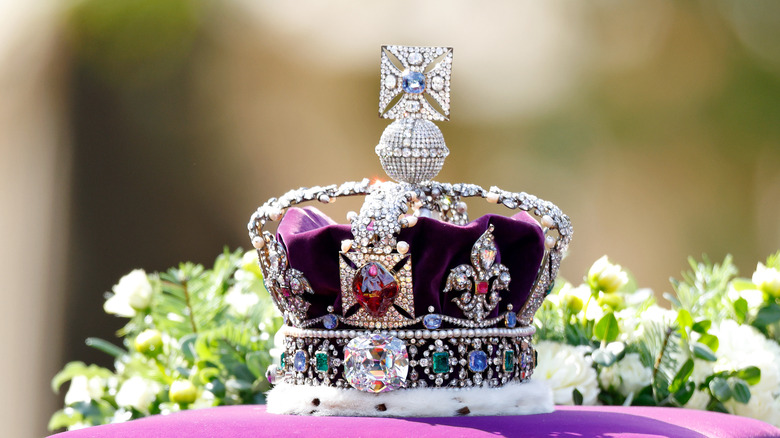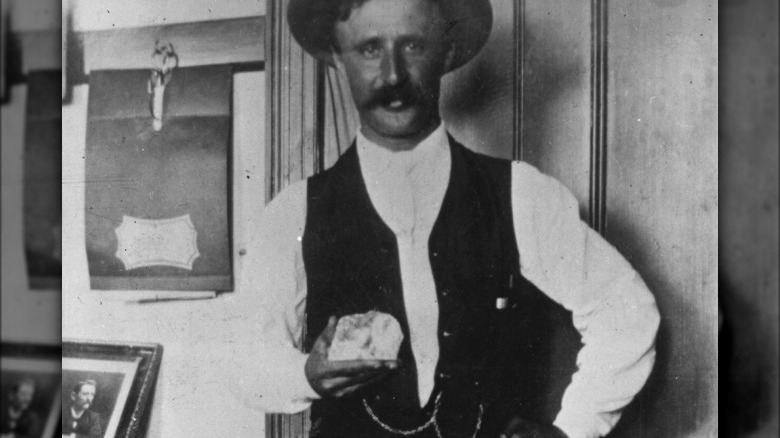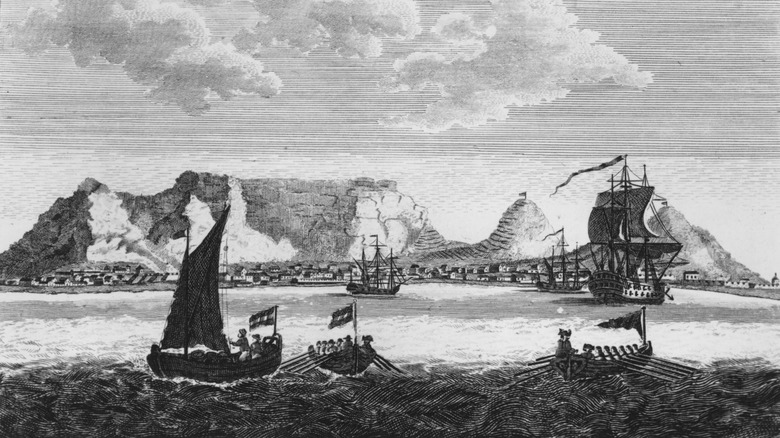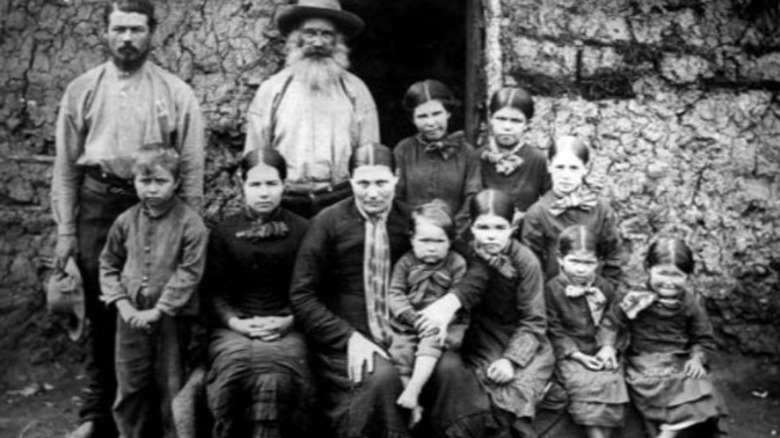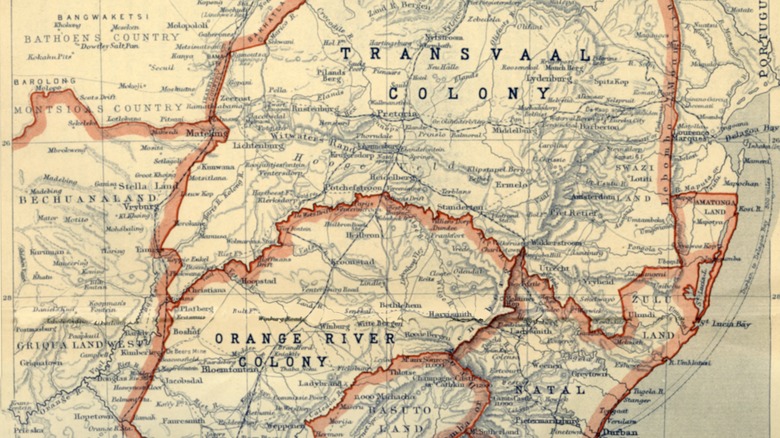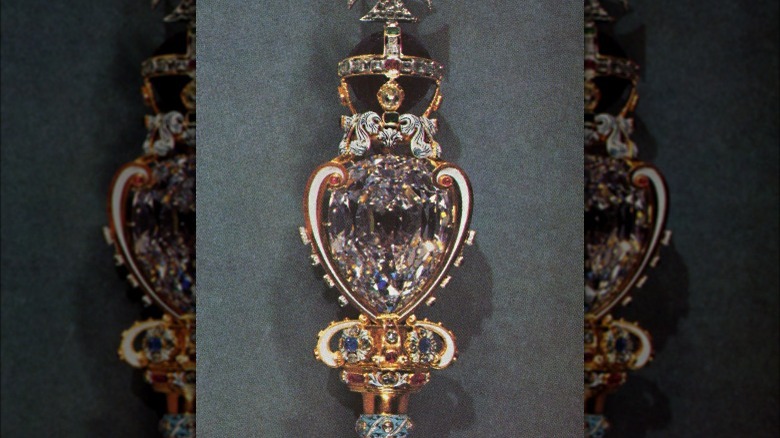The Controversial History Of The Cullinan Diamond Used In The Queen's Coffin Crown
In the wake of Queen Elizabeth II's death, controversy about some of the Royal Family's most prized jewels has begun to arise once again. Some argue that the jewels represent the Royal Family's legacy with imperialism and colonialism, and to put them on exhibit at Her Majesty's funeral would be an insult to people around the world who have been oppressed by the British Empire and subsequently the royals themselves. One of these controversial diamonds is the Cullinan diamond that is implanted inside the queen's coffin crown.
The gem that is integrated into the queen's coffin crown is known as the Second Star of Africa. It comes from a South African mine that was once owned by Thomas Cullinan (hence the name) and is the second-largest cut gem from the diamond, according to ABC. But what was the largest cut gem then? Well, the British royal family actually possesses this one as well, and is known as the Great Star of Africa, and is the largest diamond-cut gem in the world, weighing a whopping 530.2 carats, per Snopes. But the history of the Cullinan diamond is shrouded in war and violence.
The Origin of the Diamond
The Cullinan diamond was discovered in 1905 and weighed 3,106 carats in its uncut form per Britannica – or 1.33 pounds as Natural Diamonds explains. Before its discovery, the largest uncut diamond that had ever been discovered was the Excelsior diamond, which had also been discovered from a South African mine in the province of Orange Free State on June 3rd, 1893, by a worker who had been loading a truck (via Britannica). The Excelsior diamond weighed 995 carats when it was found and was sold to the famous I.J. Asscher and Company of Amsterdam for cutting, the same company that was also responsible for cutting the Cullinan diamond.
After the Cullinan diamond was discovered in 1905, it was sold to the local Transvaal government before being presented to the king of England at the time, King Edward VII. The diamond was given to the British as a way to make amends for the bloody Boer War which had just taken place a few years earlier, according to ABC.
Imperialism in South Africa
In order to understand the origins of the Boer War, context is needed. The first European to discover South Africa was Bartolomeu Dias in 1488, when the Portuguese sailor went around an area he named the Cape of Good Hope. The land was originally inhabited by nomadic people groups known as the San and Khoikhoi people who were often referred to as Khoisan people by the Europeans, according to Encyclopedia. In 1652, the Dutch East India Company made a permanent settlement known as Cape Town, which was used as a supply station from the Netherlands to the colonies in the East.
Due to the French Revolution and the Napoleonic Wars, British forces were occupying the Cape Town colony in 1795 and officially ruled the colony 11 years later, in 1806. With it, the British brought their own way of life and abolished slavery, and the Boers, which were descendants of Dutch and French colonists, went north to escape the British colony and established their own independent governments known as the Boer republics, according to Encyclopedia.
The Transvaal People
In the 1830s, a group of 12,000 Boers left Cape Town and ventured into the northern part of South Africa. After warring with the local Ndebele people, the Boers were able to claim sovereignty over all the land between the Limpopo and Vaal river, hence where the name "Transvaal" comes from, literally meaning across the Vaal, according to Britannica. However, infighting within the Transvaal government made it hard to have good leadership, but when the British invaded the Boer Republic of Natal, more and more Boers left Cape Town and emigrated to the Transvaal.
Discoveries of gold and diamonds made the British interested in the Transvaal republic, and in 1877 Sir Theophilus Shepstone conquered the republic for Great Britain. In 1881, the Boers revolted against their British rulers and established a new Transvaal government, known as the South African Republic. A new problem arose for the Boers in 1886, when large gold deposits attracted more and more Europeans, dubbed Uitlanders who were mostly Germans and Englishmen, to emigrate to the Transvaal region in hopes of becoming rich. Soon, Europeans outnumbered the local Boers by double, which led to internal conflicts within the republic, and eventually the Boer War.
The Boer War
Eventually, the bubble burst between the local Boers and the European immigrants, when Dr. Leander Starr Jameson attempted to start an uprising by the new Uitlanders, but it failed dramatically. This only heightened tensions between the two groups and as a result of the failed coup, Colonial Secretary Joseph Chamberlain appointed Sir Alfred Milner, a staunch imperialist, as High Commissioner in 1897, according to National Army Museum. This coup also led to the reelection of Paul Kruger as president of the new South African Republic in 1898, the same man who opposed giving the European immigrants political power.
Kruger then proposed that the South African Republic would give the European immigrants more power, and in return, the British government would stop claiming they ruled the SAR. Chamberlain declined this proposal, and so the SAR invaded Cape Town and other British colonies, culminating in a war between the two nations, and the Boers proved to be a powerful force to be dealt with. It's estimated 400,000 soldiers were involved in the Boer War, according to National Army Museum. The British also created concentration camps for the Boers and local Africans, but in 1902 the war finally came to an end, and the nations attempted to make amends.
The Legacy of the Cullinan Diamond
After the Boer War ended, the South African Republic gradually became integrated into Britain's colony, and three years after the war ended was when the Cullinan Diamond had been discovered. Since it was given to the royal family in 1907, the Cullinan diamond has been used in royal regalia. The Great Star of Africa, also known as Cullinan I, was integrated into the Sovereign's Sceptre with Cross, which was used for a coronation in 1910, according to ABC. The Second Star of Africa, or Cullinan II, the second-largest gem cut from the Cullinan diamond was added to the Imperial State Crown for King George VI's coronation in 1937. This crown was laid atop Queen Elizabeth II's coffin in preparation for her funeral.
Given the legacy of the diamonds, dating back to the dark Boer war, many have criticized the royal family for utilizing these jewels, claiming that the British empire stole them from colonial Africa. But, it is still a matter of debate if the British monarchy actually stole the Cullinan diamond, or if it is their rightful property. Nevertheless, the diamond carries with it a legacy of bloodshed that continues to follow the monarchy to this day.
